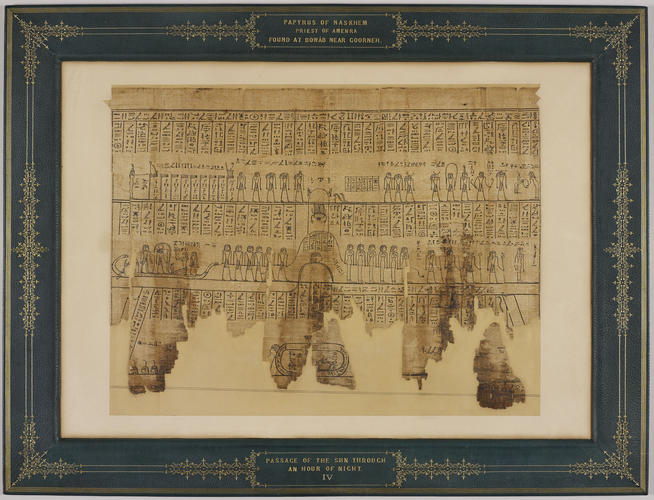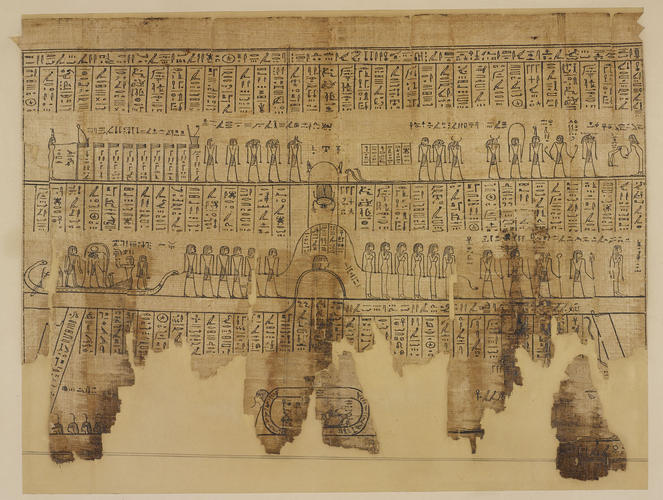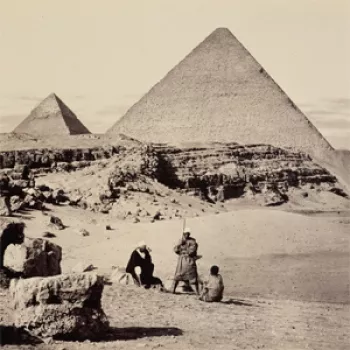Section of the papyrus belonging to Nesmin, with the fifth hour of the Amduat c.300-275 BC
61.5 x 80.5 cm (mount) (whole object) | RCIN 1145262
-
Section of the papyrus belonging to ‘God’s Father and Prophet of Amun-Ra, King of the Gods, Nesmin, born of the Lady of the House, Sistrum-player of Amun-Ra, Tasherit(en-ta)ihet’ with the fifth hour of the Amduat (see also RCINs 1145259-64).
The Amduat (literally ‘that which is in the netherworld’), also known as the Book of the Hidden Chamber, is a funerary text that describes the journey of regeneration of Ra, the Egyptian sun god, through the 12 hours of the night from sunset (symbolising death) to sunrise (symbolising rebirth). The text starts appearing in royal tombs from around 1500 BC, and the two most notable examples are perhaps those painted on the walls of the burial chambers of Thutmose III (1479–1425 BC) and Amenhotep II (1427–1400 BC) in the Valley of the Kings, Thebes. It represents an important stepping stone in the literary tradition of ancient Egypt, being the model for later Books of the Afterlife, and it maintains its relevance well into the Graeco-Roman era.
The main aim of the text is to offer a description of the netherworld so that the deceased, as well as the living, are able to gain familiarity with what to expect when their journey into the afterlife begins. Knowledge of the secret paths of the netherworld offers protection to the deceased from the dangers and threats he/she may encounter; the text shows the obstacles and demons that could obstruct a safe passage through the hereafter as well as the deities and beings able to assist and help the deceased towards the completion of the journey of regeneration.
In the fifth hour, Ra's solar barque (Mesektet) is towed by six male deities and, once passed the mound with the head of Isis, by six female deities. Isis seems here to be sheltering the nocturnal course of Ra in a similar fashion to Nut, the sky goddess, who protects the course of the sun god in the daytime by bending over and stretching to touch with her hands and feet the eastern and western horizons.
Isis, wife and sister of Osiris and mother of Horus, offers protection to Ra but also her powers of healing and renewal of life. Above her head, on the upper register, guarded by Anubis and mourned by the wailing Isis and Nephthys both in their bird-form, is the burial mound of Osiris. The body of Isis's husband/brother is not shown but a scarab beetle is depicted emerging from the mound. Once again, Khepri, the rejuvenated morning form of the sun god, appears in the text emphasising the concept of renewal, a nocturnal process common to both Osiris and Ra. On the upper register, a full theory of deities are present at the scene including nine flags (a flag/flagpole is the hieroglyph for 'god') indicating the Great Ennead of Heliopolis (but with Kephri in the place of Atum and Horus in that of Set). The Great Ennead is the group of nine gods generally associated with the creation of the world and in this case, particularly with the substitution of the two gods, the concept of creation is still present but enriched by that of re-creation or, in other words, continuity of creation through regeneration.
Renewal and regeneration is also the main theme in the lower register which, despite being only partially preserved in this case, is centred on the oval 'cavern of Sokar', embedded between two halves of the double sphinx Aker, an earth-god associated with the junction of the two horizons in the netherworld (therefore guarding its entrance and exit gates). The falcon-headed god Seker stands inside the cavern on a winged serpent with one human head and three other snake heads which is interpreted as an animal form of the sun god, connected in particular with his 'secret flesh' (i.e. his corpse). It is inside the cavern of Seker that the sun god starts his actual renewal. Below the cavern, all along the bottom of the lower register, is the 'lake of fire'.
Egyptologist Samuel Birch published his study of the papyrus in 1863 (RCIN 1079232). A facsimile was published in 1913 with the hieroglyphic transcripts, translations and an introduction by E.A. Wallis Budge.
A more recent English translation of the complete text of the Amduat can be found in Hornung, E and Abt, T eds, 2007. The Egyptian Amduat. The Book of the Hidden Chamber. Zurich: Living Human Heritage, while a psychological interpretation of the text is presented in Schweizer, A, 2010. The Sungod’s Journey through the Netherworld. Reading the Ancient Egyptian Amduat. Ithaca, NY and London: Cornell University Press.Provenance
Excavated in Egypt at the Dra' Abu el-Naga' necroplis, near Deyr el-Bahri, part of the larger Theban necropolis, 1862 by Mustafa Aga Ayad, consular agent to the United Kingdom. Acquired by King Edward VII, when Prince of Wales, during his 1862 tour of the Middle East.
-
Measurements
61.5 x 80.5 cm (mount) (whole object)
39.8 x 54.2 cm (sheet of paper)
86.5 x 67.0 cm (book in box)
Category
Alternative title(s)
Passage of the sun through an hour of the night ; 4. (Papyrus of Nas-Khem Priest of Amen-Ra).











